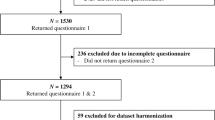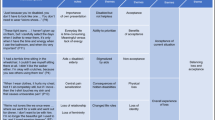Abstract
Study design
Longitudinal community survey.
Objectives
To describe the treatment for secondary health conditions as reported by individuals living with spinal cord injury (SCI) and to identify potential predictors of treatment.
Setting
Community (people with SCI living in Switzerland).
Methods
Data on the frequency, severity, and treatment of 14 common health conditions (HCs) in the past three months were collected in two surveys by the Swiss Spinal Cord Injury (SwiSCI) cohort study, in 2012 and 2017. Variation in treatment was analyzed using descriptive statistics, by survey period and severity of HC. Conditional multilevel random-effects logistic regression was used to describe differences in self-reported treatment with respect to sociodemographic and socioeconomic factors in addition to SCI characteristics and severity and number of HCs.
Results
Severe or chronic autonomic dysreflexia and sleep problems showed in the self-report as the HCs with the lowest occurrence/frequency of treatment. Across all HCs, higher age, shorter time since injury, the total number of HCs, and level of severity were associated with a higher propensity for reporting treatment. Individuals with severe financial difficulties additionally had 1.40 greater odds of receiving treatment (95% CI 1.09–1.80).
Conclusions
This study identified systematic differences in the report of HCs and their treatment within the Swiss SCI community. This study thus provides a basis to guide future research on identifying targets of intervention for long-term clinical management of SCI.
Similar content being viewed by others
Log in or create a free account to read this content
Gain free access to this article, as well as selected content from this journal and more on nature.com
or
References
Dryden DM, Saunders LD, Rowe BH, May LA, Yiannakoulias N, et al. Utilization of health services following spinal cord injury: a 6-year follow-up study. Spinal Cord. 2004;42:513–25.
Brinkhof MW, Al-Khodairy A, Eriks-Hoogland I, Fekete C, Hinrichs T, et al. Health conditions in people with spinal cord injury: Contemporary evidence from a population-based community survey in Switzerland. J Rehabil Med. 2016;48:197–209.
van der Meer P, Post MW, van Leeuwen CM, van Kuppevelt HJ, Smit CA, et al. Impact of health problems secondary to SCI one and five years after first inpatient rehabilitation. Spinal Cord. 2017;55:98–104.
Krause JS, Saunders LL. Health, secondary conditions, and life expectancy after spinal cord injury. Arch Phys Med Rehabil. 2011;92:1770–5.
Chamberlain JD, Gmunder HP, Hug K, Jordan X, Moser A, et al. Differential survival after traumatic spinal cord injury: evidence from a multi-center longitudinal cohort study in Switzerland. Spinal Cord. 2018;56:920–30.
Buzzell A, Chamberlain JD, Gmünder HP, Hug K, Jordan X, et al. Survival after non-traumatic spinal cord injury: evidence from a population-based rehabilitation cohort in Switzerland. Spinal Cord. 2018;57:267–75.
Noonan VK, Fallah N, Park SE, Dumont FS, Leblond J, et al. Health care utilization in persons with traumatic spinal cord injury: the importance of multimorbidity and the impact on patient outcomes. Top Spinal Cord Inj Rehabil. 2014;20:289–301.
Penchansky R, Thomas JW. The concept of access: definition and relationship to consumer satisfaction. Med Care. 1981;19:127–40.
Krause JS, Carter RE. Risk of mortality after spinal cord injury: relationship with social support, education, and income. Spinal Cord. 2009;47:592–6.
Krueger H, Noonan VK, Trenaman LM, Joshi P, Rivers CS. The economic burden of traumatic spinal cord injury in Canada. Chronic Dis Inj Can. 2013;33:113–22.
Lahelma E, Martikainen P, Laaksonen M, Aittomaki A. Pathways between socioeconomic determinants of health. J Epidemiol Community Health. 2004;58:327–32.
Muller R, Landmann G, Bechir M, Hinrichs T, Arnet U, et al. Chronic pain, depression and quality of life in individuals with spinal cord injury: Mediating role of participation. J Rehabil Med. 2017;49:489–96.
Sangha O, Stucki G, Liang MH, Fossel AH, Katz JN. The self-administered comorbidity questionnaire: a new method to assess comorbidity for clinical and health services research. Arthritis Rheum. 2003;49:156–63.
Katz JN, Chang LC, Sangha O, Fossel AH, Bates DW. Can comorbidity be measured by questionnaire rather than medical record review? Med Care. 1996;34:73–84.
Post MW, Brinkhof MW, von Elm E, Boldt C, Brach M, et al. Design of the Swiss spinal cord injury cohort study. Am J Phys Med Rehabil. 2011;90:5–16.
Brinkhof MW, Fekete C, Chamberlain JD, Post MW, Gemperli A. Swiss national community survey on functioning after spinal cord injury: protocol, characteristics of participants and determinants of non-response. J Rehabil Med. 2016;48:120–30.
Gross-Hemmi MH, Gemperli A, Fekete C, Brach M, Schwegler U, et al. Methodology and study population of the second Swiss national community survey of functioning after spinal cord injury. Spinal Cord. 2020; https://doi.org/10.1038/s41393-020-00584-3.
Swiss Spinal Cord Injury Cohort Study (SwiSCI). Survey 2017 [Internet]. Nottwil: Schweizer Paraplegiker-Forschung; 2018; https://www.swisci.ch/en/research-projects-home/study-design/community-survey.
Kalpakjian CZ, Scelza WM, Forchheimer MB, Toussaint LL. Preliminary reliability and validity of a Spinal Cord Injury Secondary Conditions Scale. J Spinal Cord Med. 2007;30:131–9.
Cieza A, Kirchberger I, Biering-Sorensen F, Baumberger M, Charlifue S, et al. ICF core sets for individuals with spinal cord injury in the long-term context. Spinal Cord. 2010;48:305–12.
DeVivo MJ, Biering-Sorensen F, New P, Chen Y. Standardization of data analysis and reporting of results from the international spinal cord injury core data set. Spinal Cord. 2011;49:596–9.
Baayen RH. Mixed-effects modeling with crossed random effects for subjects and items. J Mem Lang. 2007;59:390–412.
Yu H-T. Applying linear mixed effects models with crossed random effects to psycholinguistic data: multilevel specification and model selection. Quant Meth Psych. 2015;11:78–88.
Pinheiro JC, Chao EC. Efficient laplacian and adaptive gaussian quadrature algorithms for multilevel generalized linear mixed models. J Comput Graph Stat. 2006;15:58–81.
Twisk J. Missing data in logitudinal studies. In: applied longitudinal data analysis for epidemiology: a practical guide. Cambridge: Cambridge University Press; 2013. pp 212–36.
Thompson L. Functional changes in persons aging with spinal cord injury. Assist Technol. 1999;11:123–9.
Ronca E, Scheel-Sailer A, Koch HG, Essig S, Brach M, et al. Satisfaction with access and quality of healthcare services for people with spinal cord injury living in the community. J Spinal Cord Med. 2018;43:111–21.
Wetzel E, Böhnke JR, Brown A. Response biases. In: Long FTL, Bartram D, Cheung FM, Geisinger KF, Iliescu D, editors. The ITC International Handbook of Testing and Assessment. UK: Oxford University Press Oxford; 2016. pp 349–63.
Yarkoni T. The generalizability crisis. 2019. https://doi.org/10.31234/osf.io/jqw35.
Acknowledgements
We thank the SwiSCI Steering Committee with its members Xavier Jordan, Fabienne Reynard (Clinique Romande de Réadaptation, Sion); Michael Baumberger, Hans Peter Gmünder (Swiss Paraplegic Center, Nottwil); Armin Curt, Martin Schubert (University Clinic Balgrist, Zürich); Margret Hund-Georgiadis, Kerstin Hug (REHAB Basel, Basel); Laurent Prince (Swiss Paraplegic Association, Nottwil); Heidi Hanselmann (Swiss Paraplegic Foundation, Nottwil); Daniel Joggi (Representative of persons with SCI); Nadja Münzel (Parahelp, Nottwil); Mirjam Brach, Gerold Stucki (Swiss Paraplegic Research, Nottwil); Armin Gemperli (SwiSCI Coordination Group at Swiss Paraplegic Research, Nottwil).
Funding
SwiSCI is hosted and funded by Swiss Paraplegic Research.
Author information
Authors and Affiliations
Contributions
KC and MWGB were responsible for designing and planning the conceptual framework of the present study. AB, KC, and MWGB were responsible for data analysis, interpretation, and development of the present manuscript. IEH, KH, XJ, and MS provided clinical support, feedback on the manuscript, and support in data collection at their respective clinics. JC contributed critical feedback on the manuscript. All authors participated in a critical revision of this manuscript for important intellectual content and ultimately approved of the final version based on this submission.
Corresponding author
Ethics declarations
Conflict of interest
The authors declare that they have no conflict of interest.
Ethical approval
Ethical approval for Survey 2012 was granted by the principal ethics committee on research involving humans of the Canton of Lucerne (KEK Luzern, internal application 11042, approved 28.06.2011) and subsequently endorsed by the additional involved cantonal ethics committees of Cantons Basel-Stadt (EK Basel, internal application 306/11, approved 06.09.2011) and Valais (CCVEM Sion, internal application CCVEM042/11, approved 06.12.2011). Ethical approval for Survey 2017 was granted by the leading ethical institution Ethikkommision Nordwest-und Zentralschweiz (EKNZ, Project-ID: 11042 PB_2016-02608, approved Dec 2016). We certify that all applicable institutional and governmental regulations concerning the ethical use of human volunteers were followed during the course of this research.
Additional information
Publisher’s note Springer Nature remains neutral with regard to jurisdictional claims in published maps and institutional affiliations.
Supplementary information
Rights and permissions
About this article
Cite this article
Buzzell, A., Camargos, K.C., Chamberlain, J.D. et al. Self-reports of treatment for secondary health conditions: results from a longitudinal community survey in spinal cord injury. Spinal Cord 59, 389–397 (2021). https://doi.org/10.1038/s41393-020-00596-z
Received:
Revised:
Accepted:
Published:
Issue date:
DOI: https://doi.org/10.1038/s41393-020-00596-z



